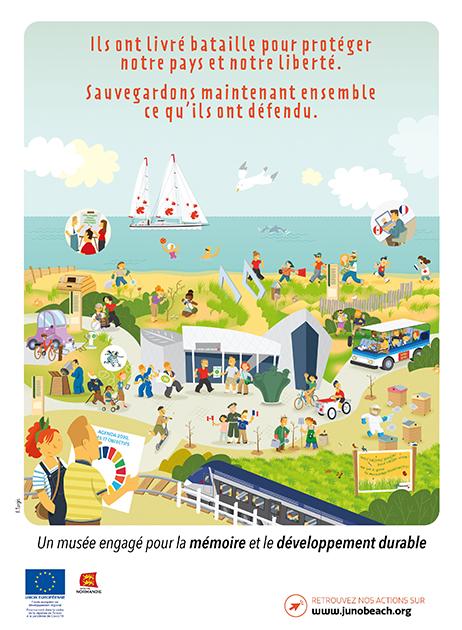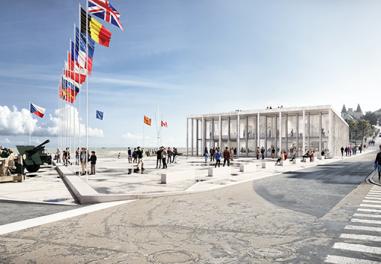The Juno Beach Centre
Founded in 2003 by veterans and their families, the Juno Beach Centre (JBC) is the only Canadian museum on the Normandy coast. While its purpose remains that of passing on the history and memory of the liberators of 1944, today it is committed to doing so sustainably.

The Juno Beach Centre’s commitment to sustainable development got properly underway in 2019. Located on a coastline rich in biodiversity, it had just passed the milestone of 100 000 visitors per year, which prompted it to consider the impacts of mass tourism. Surrounded by the sea, a river and a port, the museum is susceptible to the threats of climate change and urban development.
During the periods of lockdown in 2020, a sustainable development strategy and action plan were drawn up, linked to a CSR (Corporate Social Responsibility) strategy and aligned with the UN Sustainable Development Goals. After mapping out the challenges and impacts, an overall approach was set out, embodied in four pillars of action:
- Reduce direct and indirect environmental impact and create a circular economy;
- Engage with visitors and commit to employees;
- Take action to protect biodiversity;
- Work with others.
Beginning in 2020, the first significant actions sought to involve visitors and develop partnerships with like-minded local organisations. One key initiative was to produce a report on the greenhouse gas (GHG) emissions associated with the museum’s activities. The not unexpected conclusion – that visitor transport accounted for 80% of emissions – led the JBC to team up with French rail operator SNCF to offer cut-price admission to visitors travelling by train. In the same vein are actions in line with local cycling development policies, and the desire is to go ever further. The museum is also committed to following best practice in the use of sustainable, environmentally friendly displays. Its latest exhibition, “From Dieppe to Juno”, was designed using 95% of the display material from the previous exhibition.
Within the museum team, a process of co-construction aims to ensure everyone finds their place, with the aid of a road map coordinated by the management. A 5% reduction per year in the museum’s GHG emissions, in line with the Paris Agreement, is among the priority targets. A list of actions to be undertaken (saving energy, waste management, staff VPN, virtual tours, etc.) and a timescale are also presented.
Concerning funding, some projects are “zero cost”, for instance the suggested eco-friendly practices for staff and visitors. Others are funded out of the museum’s operating budget. As regards the large-scale projects, applications have been made for external funding, some of which has already been secured. For example, the museum’s planned upgrade in preparation for a sustainable extension project (eco-friendly coffee shop and low-carbon gift shop) is in receipt of regional and European funding.
The JBC is in step with a move towards responsible tourism locally, regionally and nationally. It must adapt in order to get the message across to its audience and convince its partners to join with it, without overshadowing its primary purpose: remembrance, the link with Canada and actions to attract and welcome visitors. Museums, and centres for remembrance in particular, have a role to play in raising public awareness about sustainable development issues. Rooted in their localities, yet outward-looking and multicultural, they are ready to welcome and listen to all comers and, ultimately, are working to make learning accessible, fun and engaging, while also developing environmental awareness.
Read more
Lieu de mémoire
Articles of the review
-
The file

Remembrance tourism in Normandy
Every year, remembrance tourism attracts millions of visitors to Normandy to walk in the footsteps of the liberators of 1944, bringing with it economic, cultural and civic benefits. The Normandy Region is a leading actor of the tourism sector, and works to create synergies around shared projects and...Read more -
The event

Normandy museums under renovation
To combine a high-quality visitor experience with preserving their collections, the Musée du Débarquement in Arromanches and the Airborne Museum in Sainte-Mère-Église are having a facelift. The directors of the two museums discuss the renovation projects that are underway. ...Read more -
The interview
Remembering the Dieppe Raid
The town of Dieppe, in Seine-Maritime, is preparing to commemorate the 80th anniversary of the raid that bears its name. Stéphane Canu, the town council’s head of communications, and Martine Pietrois, chair of the Jubilee Association, look back at this chapter of Franco-Canadian history and discuss ...Read more

